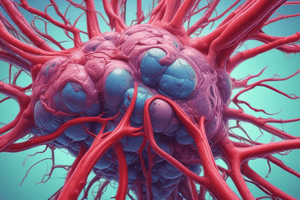Podcast
Questions and Answers
What is the net filtration pressure at the arterial end of the capillaries?
What is the net filtration pressure at the arterial end of the capillaries?
- Negative
- Positive (correct)
- Variable
- Zero
What is the primary function of the lymphatic system?
What is the primary function of the lymphatic system?
- To produce antibodies
- To preserve fluid balance and transport fats and foreign materials (correct)
- To regulate blood pressure
- To remove waste products from the body
What allows for the one-way entry of fluid into lymphatic capillaries?
What allows for the one-way entry of fluid into lymphatic capillaries?
- Semi-permeable membranes
- Tissue compression
- Intercellular clefts (correct)
- One-way valves
What is responsible for pumping fluid forward in the lymphatic system?
What is responsible for pumping fluid forward in the lymphatic system?
What is the purpose of afferent lymphatic trunks?
What is the purpose of afferent lymphatic trunks?
What is the function of lymph nodes in the lymphatic system?
What is the function of lymph nodes in the lymphatic system?
What is the pressure required to prevent pumping in the lymphatic system?
What is the pressure required to prevent pumping in the lymphatic system?
What is the destination of efferent lymphatic trunks?
What is the destination of efferent lymphatic trunks?
What is the primary function of the microcirculation in the vascular system?
What is the primary function of the microcirculation in the vascular system?
What is the main reason for increased capillary pressure in heart failure?
What is the main reason for increased capillary pressure in heart failure?
What is the result of increased venular permeability due to inflammation?
What is the result of increased venular permeability due to inflammation?
What is the typical pressure gradient through the capillaries?
What is the typical pressure gradient through the capillaries?
What is a consequence of lymphatic obstruction?
What is a consequence of lymphatic obstruction?
Which of the following is NOT a factor contributing to oedema formation?
Which of the following is NOT a factor contributing to oedema formation?
What is the result of decreased plasma oncotic pressure?
What is the result of decreased plasma oncotic pressure?
What is the term for the principle that describes fluid balance in the microcirculation?
What is the term for the principle that describes fluid balance in the microcirculation?
Flashcards are hidden until you start studying
Study Notes
Learning Outcomes
- Understanding how water and substances cross the capillary wall
- Familiarity with the Starling principle concerning fluid balance in microcirculation
- The lymphatic system's function in regulating interstitial fluid balance
- Identification of four key factors contributing to oedema formation
Microcirculation
- Composed of terminal arterioles, capillaries, and post-capillary venules
- Key site for gas, water, nutrient, and waste exchange between blood and tissues
- Forms a three-dimensional meshwork of blood vessels facilitating absorption and lymphatic flow
- Oedema can arise from:
- Increased capillary hydrostatic pressure (e.g., heart failure, thromboembolism)
- Elevated capillary or venular permeability (e.g., inflammation)
- Decreased plasma oncotic pressure (e.g., malnutrition, burns, liver dysfunction)
- Lymphatic obstruction (e.g., lymph node removal, inflammation, parasitic invasion)
Capillary Pressures
- Pressure gradient exists in capillaries: ~30 mmHg at the arterial end and ~10 mmHg at the venous end
- Net Filtration Pressure (NFP) is positive at the arterial end and negative at the venous end
- Approximately 90% of fluid lost at arterial end returns via venous capillaries; remaining fluid is cleared by lymphatics
The Lymphatic System
- Essential for preserving fluid balance and transporting absorbed fats from the small intestine to the circulatory system
- Transports foreign materials to lymph nodes for immune surveillance
- Composed of lymphatic capillaries with intercellular clefts allowing one-way fluid entry
- Fluid movement is driven by tissue compression and facilitated by lymphangions, which act as miniature hearts
- Smooth muscle contractions in lymphatic trunks aid in fluid transport and require tissue compression between 40-50 mmHg to function effectively
Lymphatic Drainage
- Afferent and efferent lymphatics connect to major blood vessels, delivering lymph to either the thoracic duct or the right subclavian duct
- Lymph nodes play a crucial role in reabsorbing some lymph fluid and facilitating immune responses
Studying That Suits You
Use AI to generate personalized quizzes and flashcards to suit your learning preferences.




